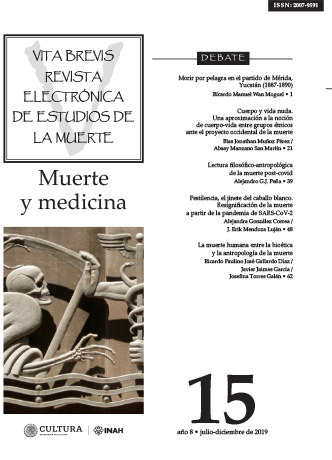Pestilencia, el jinete del caballo blanco. Resignificación de la muerte a partir de la pandemia de SARS-CoV-2
Published 2023-02-28
Keywords
- SARS-CoV-2,
- Pandemia,
- Muerte,
- Enfermedad,
- Coronavirus
Copyright (c) 2019 Instituto Nacional de Antropología e Historia

This work is licensed under a Creative Commons Attribution-NonCommercial 4.0 International License.
How to Cite
Abstract
Since ancient times, the human being has faced various calamities of natural order, which have left death and destruction, directly or indirectly affecting the daily lives of human beings and various animals. It is worth mentioning that these effects have occurred in the form of earthquakes, tsunamis, floods, hurricanes, various diseases that have been caused by any virus or bacteria, which due to their transmission capacity become epidemics or pandemics, the latter being the one that is currently affecting the world population considerably. In this work there will be a brief historical overview of the various diseases that have affected human life over time.
Downloads
References
- Aragón Nogales, Ranferi, Iván Vargas Almanza y María Guadalupe Miranda Novales, “Coronavirus 2019: la más reciente emergencia de salud”, Revista Mexicana de Pediatría, vol. 86, núm. 6, 2019, pp. 213-218.
- Burstein Alva, Zuño, “Viruela (CIE-9-050, CIE-10 B03)”, Revista Peruana de Medicina Experimental y Salud Pública, vol. 20, núm. 1, 2003, pp. 58-60.
- Delgado Rubio, A. y J. Picazo de la Garza, “Gripe en el niño. Una enfermedad prevenible”, Anales de Pediatría. Asociación Española de Pediatría, vol. 62, núm. 1, 2005, pp. 1-4.
- Firth, Raymond W., Tipos humanos. Una introducción a la antropología social, Buenos Aires, Eudeba SEM, 1961.
- Freud, Sigmund, “Inibizione, sintomo e angoscia e altri scritti (1924-1929)”, en Opere, 10, Turín, Bollati Boringhieri, 1978.
- García G., Juan José, “Fundamentos para el estudio de un brote epidémico”, Revista Mexicana de Pediatría, vol. 69, núm. 5, septiembre-octubre de 2002, pp. 208-211.
- Horcajada, Juan Pablo y Belén Padilla, “Endemia y epidemia. Investigación de un brote epidémico nosocomial”, Enfermedades Infecciosas y Microbiología Clínica, vol. 31, núm. 3, 2013, pp. 181-186.
- Leal Becker, Rodrigo, “Breve historia de las pandemias”, Bibliopsiquis, vol. 24, 2020.
- Moreno Sánchez, Francisco, María Fernanda Coss Rovirosa, María Teresa Alonso de León y Álvaro Elizondo Ochoa, “Las grandes epidemias que cambiaron al mundo. Historia y filosofía de la medicina, Anales Médicos. Asociación Médica del Centro Médico ABC, vol. 63, núm. 2: Historia y filosofía de la medicina, abril-junio de 2018, pp. 151-156.
- Parkes, C.M., Bereavment. Studies of Grief in Adult Life, Londres, Hardmondsworth, 1972.
- Rius i Gibert, Cristina, “La peste a lo largo de la historia”, Revista de Enfermedades Emergente, vol. 18, núm. 3, 2019, pp. 119-127.
- Sartre, J.P., L’être et le néant, París, Editions du Seuil, 1980.
- Sáez, Andrés, “La peste antonina: una peste global en el siglo II d.C.”, Revista Chilena de Infectología, vol. 33, núm. 2, 2016, pp. 218-221.
- Thomas, Louis-Vincent, Antropología de la muerte, FCE, México, 1989.
- Ziegler, Philip, The Black Death, Dover, New Hampshire, Alan Sutton, 1993.

